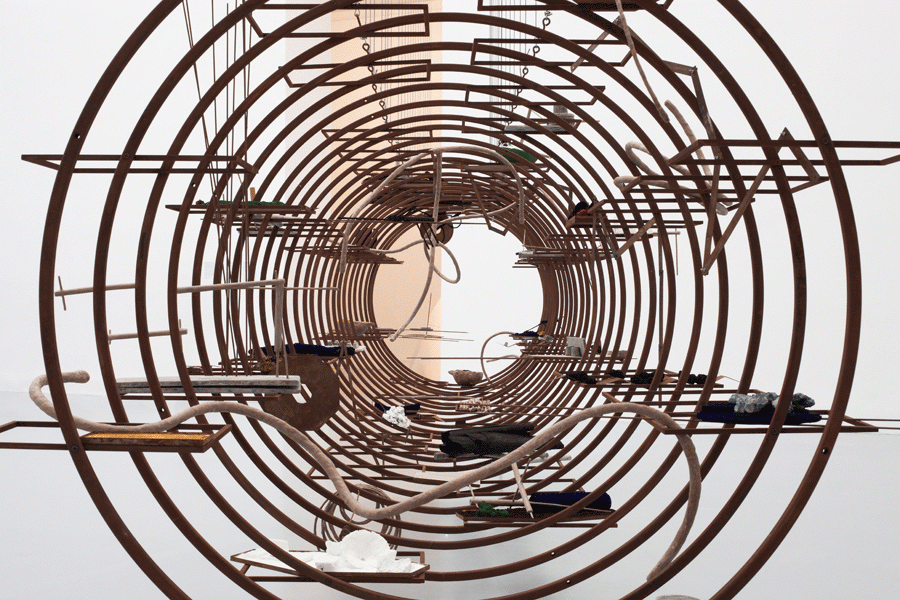Five metres of looped handmade hemp and asphalt-rubber rope hang in drooping arcs from the ceiling of the Zacheta National Gallery of Art in Warsaw. Below, suspended by a series of cables also attached to the ceiling, is a large rusting structure hovering half a metre or so above the gallery floor – 25 metal hoops connected to form a tunnellike frame. This installation – the rope titled Arena (2014), the suspended sculpture Turba, Turbo (2015) – was Iza Tarasewicz’s contribution to the nominees exhibition of the 2015 Views Award, Poland’s biggest art prize, which the artist went on to win.
I encountered Turba, Turbo again a year later, at the Bienal de São Paulo (visitors to the 2016 Gwangju Biennale would have the chance to see a version of Arena). Or rather, I encountered a work under the same title – probably the same metal structure – but with various subtle differences. Throughout both iterations, a series of small platforms, in identical rusting metal, are attached to the looping frame. On these sit semiprecious stones, rope coils and piles of variously coloured pigments – dark red iron oxide, green chromium oxide, light sodium silicate and more. The exact arrangements differed, however, and there were other slight changes: this version was floor-based; both installations had metal discs attached across the work, but the São Paulo version had more; conversely, I seem to remember a larger amount of stones in the Warsaw work. Later I discover that Tarasewicz has shown the work with sections of the hoops hanging individually from the ceiling, in a show at the Kostka Gallery in Prague.
Tarasewicz explores chaos theory through the choices she makes in the production and installation of her art: every small variation inextricably changing the work’s effect on the viewer
These changes to a single work resonate with the context of Tarasewicz’s wider artmaking and the research that fuels it. In Warsaw, the artist told me of her interest in chaos theory and how the slightest variances can effect great change. She is also interested in hylozoism, the idea that all matter, in some sense, is ‘alive’. While these ideas are commonly spoken of within the framework of mathematics, physics and philosophy, Tarasewicz explores them in the aesthetic realm through her intricate sculptural installations. Knight’s Tour (2016), for example, made during a residency in Tbilisi, takes a diagram of the moves a knight might make on a chessboard and uses it as the basis for a (again, ceiling-hung) work that replicates the piece’s route in three-dimensional space through a series of jointed wood poles. As all chess players know, the choice between any two moves will radically alter how the game develops. In another project, developed for the Bienal de São Paulo, Tarasewicz traced the pan-cultural variants to mazurka, a dance originating in sixteenth-century Poland that has now spread globally (including to Brazil).
With this theme in mind, I began to consider my own reaction to seeing Turba, Turbo in two of its iterations. Each decision in an artist’s making and installation process – that is the process, in hylozoistic terms, of catalysing the interaction of different matter – can change the effect a work has on its viewer. It struck me how precarious the Warsaw version of the installation was – how it swayed slightly; how someone knocked it at the busy prize opening, causing the work to shudder, risking the upset of the treasures resting in the pools of colour across the structure – and how much more sturdy and robust – a hulking, brutal thing – the São Paulo adaptation proved. With just the slightest of changes, they became, to all intents and purposes, two different works, two different realities.
Tarasewicz is based in Warsaw. Her work is included in a group show at Croy Nielsen, Vienna, in January and in Anu Pöder. Be Brave! Be Fragile at the Center for Contemporary Arts Estonia, Tallinn, in March. She is represented by Croy Nielsen and BWA Warszawa.
From the January & February 2017 issue, in association with K11 Art Foundation
